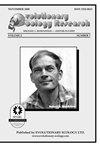Coarse- and fine-grained phenotypic divergence among threespine stickleback from alternating lake and stream habitats
Q2 Agricultural and Biological Sciences
引用次数: 9
Abstract
Background: Habitat characteristics can vary over small spatial scales at which gene flow is expected to swamp any effect of divergent natural selection. However, fine-grained (‘microgeographic’) adaptive divergence may still be feasible if individuals exhibit dispersal behaviours that improve the match between their phenotype and habitat. For example, threespine stickleback (Gasterosteus aculeatus) from lake and stream habitats maintain differences across a narrow ecotone because of non-random gene flow. However, it is unknown whether dispersal bias might also contribute to even finer-scale divergence within habitats, in response to microhabitat variation within lakes and within streams. Question: Does stickleback morphology co-vary with flow regime within stream populations, controlling for distance from adjoining lake populations? Data: We sampled stickleback along a transect through alternating lake and stream habitats. Within each stream, multiple traps were set at 50 m intervals. We recorded microhabitat data (flow rate and depth) at each trap. We measured morphology (gill rakers, head shape, fin shape, standard length) of more than 900 stickleback captured from these traps. Analysis: We used multivariate analyses of covariance and linear models to test for: (1) phenotypic divergence between lake and stream stickleback, (2) divergence among stream sites as a function of their distance from an adjoining lake, and (3) covariation between local flow regime (at each trap) and the morphology of stickleback captured from that trap. Conclusions: Fish from different flow regimes within a stream show phenotypic variation that is not due to clinal transitions from lake to stream. We found covariation between local flow regime and either fin morphology or gill raker length in different streams. The total effect size of stream microhabitat on morphology was greater than the effect size of habitat (lake vs. stream), for overall multivariate data and for a subset of univariate traits. These findings imply that local adaptation can occur on a finer spatial scale than is typically expected, perhaps as a result of non-random dispersal.湖泊和溪流交替生境中三刺鱼的粗粒和细粒表型差异
背景:在小的空间尺度上,生境特征可能会发生变化,基因流动可能会淹没任何自然选择的影响。然而,如果个体表现出改善其表型和栖息地之间匹配的分散行为,那么细粒度(“微地理”)适应分化可能仍然是可行的。例如,来自湖泊和溪流栖息地的三刺棘鱼(Gasterosteus aculeatus)由于非随机基因流动而在狭窄的过渡带中保持差异。然而,尚不清楚扩散偏差是否也可能导致栖息地内更细尺度的差异,以响应湖泊和溪流内的微栖息地变化。问题:棘鱼的形态是否与溪流种群内的水流状况共同变化,从而控制与邻近湖泊种群的距离?数据:我们沿着湖泊和溪流交替栖息地的样带取样刺鱼。在每条流中,每隔50米设置多个圈闭。我们记录了每个捕集器的微生境数据(流速和深度)。我们测量了从这些陷阱中捕获的900多条棘鱼的形态(鳃耙、头形、鳍形、标准长度)。分析:我们使用协方差和线性模型的多变量分析来检验:(1)湖泊和溪流棘鱼之间的表型差异,(2)溪流地点之间的差异作为它们与相邻湖泊距离的函数,以及(3)当地水流状况(在每个陷阱)与从该陷阱捕获的棘鱼形态之间的协变。结论:在一条河流中,来自不同水流状态的鱼表现出表型变化,这不是由于从湖泊到河流的临床转变。我们发现在不同的溪流中,局部流态与鳍形态或鳃耙长度之间存在共变。对于整体多变量数据和部分单变量特征,河流微生境对形态的总效应量大于生境(湖泊与河流)的效应量。这些发现表明,局部适应可能发生在比通常预期更小的空间尺度上,这可能是非随机分散的结果。
本文章由计算机程序翻译,如有差异,请以英文原文为准。
求助全文
约1分钟内获得全文
求助全文
来源期刊

Evolutionary Ecology Research
生物-进化生物学
自引率
0.00%
发文量
0
审稿时长
>12 weeks
期刊介绍:
Evolutionary Ecology Research publishes original research contributions focusing on the overlap between ecology
and evolution. Papers may treat any taxon or be general. They may be empirical, theoretical or a combination of the two.
EER prefers conceptual contributions that take intellectual risks or that test ideas.
 求助内容:
求助内容: 应助结果提醒方式:
应助结果提醒方式:


